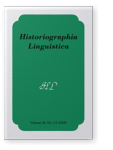Vol. 46:1/2 (2019) ► pp.105–132
Mortimer Sloper Howell (1841–1925), lecteur de Raḍī al-dīn al-Astarābāḏī (VIIe/XIIIe siècle), et deux lithographies indiennes
Cet article présente deux lithographies indiennes du Šarḥ al-Kāfiya et du Šarḥ al-Šāfiya de Raḍī al-dīn al-Astarābāḏī (m. en ou après 688/1289), faites à Delhi, respectivement en 1282/1866 et 1283/1866. Elles ont appartenu à Mortimer Sloper Howell (1841–1925), magistrat britannique en Inde et auteur d’une grammaire arabe en sept volumes parus à Allahabad entre 1880 et 1911. La grammaire de Howell suit le plan du Mufaṣṣal de Zamaḫšarī (m. 538/1144) en quatre parties : nom, verbe, particule, ce qui est commun aux trois parties précédentes ou à deux d’entre elles. Le Šarḥ al-Šāfiya est couvert d’annotations, très certainement de la main même de Howell, mais le Šarḥ al-Kāfiya en est vierge. Cela semble devoir être mis en relation avec le développement que Howell donne, dans la lignée du Šarḥ al-Šāfiya, à la quatrième partie du Mufaṣṣal, qui traite essentiellement de phonologie. C’est ce développement qui a attiré l’attention sur la grammaire de Howell et, à travers elle, le Šarḥ al-Šāfiya de Raḍī al-dīn al-Astarābāḏī de linguistes arabisants comme Jean Cantineau (1899–1956) et Henri Fleisch (1904–1985). Une enquête dans la grammaire de Howell montre que l’autre partie du Šarḥ al-Šāfiya, qui traite de morphologie, et le Šarḥ al-Kāfiya, qui traite de syntaxe, en sont des sources tout aussi importantes et, par suite, que Howell peut encore servir de médiateur entre Raḍī al-dīn al-Astarābāḏī et les arabisants.
Article outline
- 1. Introduction: Aliquando bonus dormitat Homerus
- 2.Fleisch, Howell, Raḍī al-dīn al-Astarābāḏī
- 3.Mortimer Sloper Howell
- 4.La Grammaire arabe de Howell
- 4.1Structure
- 4.2Sources
- 4.3Raḍī al-dīn al-Astarābāḏī
- 4.4 Éditions du Šarḥ al-Kāfiya et du Šarḥ al-Šāfiya utilisées par Howell
- 4.5Raḍī al-dīn al-Astarābāḏī, Howell, Cantineau et Fleisch
- 5. La partie morphologique du Šarḥ al-Šāfiya et l’exemple des formes dérivées du verbe trilitère
- 6. Le Šarḥ al-Kāfiya et l’exemple du ’inšā’
- 7.Conclusion
- Remerciements
- Remarques
-
Références
Article language: French
